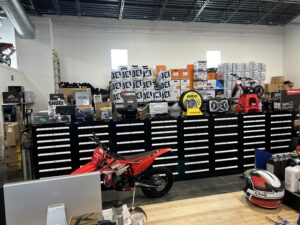Your Best Motorbike Shop for High Quality Parts and Accessories
Your Best Motorbike Shop for High Quality Parts and Accessories
Blog Article
Comprehending the Important Components of a Motorcycle: A Comprehensive Overview for Lovers
For bike enthusiasts looking to boost their riding experience and ensure their bikes run smoothly, recognizing the crucial components of a motorbike is paramount. Each component, from the engine's elaborate functions to the critical function of the stopping devices, not just influences performance yet additionally security and comfort. This overview will certainly walk with the fundamental parts that every biker should recognize with, making it possible for informed choices in both maintenance and possible upgrades. As we start this expedition, one must ask: just how does each part engage to produce the seamless ride every lover looks for?
Engine Parts

The camshaft plays a vital function in controlling the timing of the engine's shutoffs, ensuring the exact opening and closing required for reliable fuel and air consumption, in addition to exhaust expulsion. This timing is crucial to keeping ideal engine performance and effectiveness. In addition, the carburetor or fuel shot system, depending on the bike model, is accountable for mixing air with fuel in the proper proportion for combustion.
The cooling system, either air or liquid-based, functions to preserve the engine's temperature level within operational restrictions, protecting against overheating and making certain longevity - motox parts nz. Each component, diligently designed and incorporated, contributes to the smooth procedure of the engine, specifying the motorbike's power outcome and overall performance
Transmission System
Important to the bike's functionality, the transmission system makes sure reliable power transfer from the engine to the wheels. This system consists of several essential components, including the clutch, gearbox, and final drive, each playing an important duty in converting the engine's power right into movement. The clutch, commonly operated by a hand bar, offers to disengage the engine and engage from the transmission, enabling smooth equipment adjustments and regulated acceleration.
The gearbox, usually referred to as the transmission proper, contains a set of equipments that riders can manually change via to readjust the bike's speed and torque result. These gears are set up in a series that enables the bike to speed up smoothly and maintain optimum engine performance across numerous speeds. Most bikes make use of a consecutive gearbox, calling for the cyclist to move equipments in a fixed order.
Braking Systems
While understanding the transmission system is vital to taking advantage of a motorbike's power, just as essential is the ability to control and stop that power properly, which is where stopping systems enter play. Brakes are important for safety and performance, offering the biker with the essential control to browse different surfaces and problems. Commonly, motorcycles feature two types of stopping systems: disc brakes and drum brakes.
Disc brakes are a lot more prevalent in contemporary motorcycles because of their remarkable efficiency. They include a brake disc, caliper, and pads. When activated, the caliper presses the brake pads versus the rotating disc, transforming kinetic energy right into warm, consequently reducing the wheel. This system supplies much better heat dissipation, constant efficiency, and improved stopping power, particularly in wet problems.
Alternatively, drum brakes, though less usual, are still discovered in some motorbikes. They function by pushing brake footwear versus the internal surface of a drum affixed to the wheel. While usually less reliable in warm dissipation and stopping power, drum brakes are easier and more cost-efficient.
Comprehending these braking systems' subtleties enables cyclists to keep their bikes correctly and value the engineering that guarantees efficient and safe stopping.
Suspension and Steering
Suspension and steering systems are vital components that substantially affect a motorbike's handling and experience comfort. The shock absorber, being composed of forks at the front and shock absorbers at the rear, look at this website takes in roadway abnormalities, enhancing security and control. Front forks, typically telescopic or upside down, compress and rebound to reduce impacts, while back shock absorbers maintain tire call with the roadway, crucial for traction and security.
Steering, focused around the handlebars, attaches the rider to the motorcycle's directional control. The steering head bearings make certain smooth procedure, permitting accurate ability to move. Correct alignment and maintenance of these bearings are crucial for foreseeable guiding response and minimizing cyclist tiredness.
The suspension's adjustability is one more essential facet; preload, damping, and rebound setups permit customization to fit numerous riding styles and problems. This versatility is necessary for maximizing performance, whether browsing urban roads or tackling tough routes. Advancements like electronic shock absorber supply real-time modifications, improving experience top quality throughout varied surfaces.

Electric Solutions
After guaranteeing a smooth and controlled ride with efficient suspension and steering systems, focus transforms to the electrical systems, a pivotal aspect of modern motorcycles. These systems play an important function not just in starting the engine yet additionally in powering different elements that enhance the functionality and safety of the motorcycle.
At the heart of a motorcycle's electrical system is the battery, which stores electric power required for beginning the engine and powering auxiliary systems - mx gear nz. The alternator or generator, combined with the rectifier-regulator, guarantees the battery continues to be charged while the motorbike is in procedure, transforming power right into electric energy and maintaining voltage degrees
The ignition system, one more vital element, is in charge of igniting the air-fuel combination in the engine's cylinders. Modern motorcycles typically use an electronic ignition system, offering greater effectiveness and dependability contrasted to typical systems.
Lighting read what he said systems, consisting of headlights, tail lights, and signs, are additionally important, ensuring presence and security for the biker. Additional electronic components such as sensors, control systems, and displays add to advanced features like fuel injection monitoring, anti-lock braking systems (ABDOMINAL MUSCLE), and electronic dashboards, even more improving the riding experience.
Conclusion
A comprehensive understanding of a bike's essential parts, consisting of the engine, transmission system, stopping devices, suspension, guiding, and electrical systems, is vital for fanatics intending to enhance convenience, safety, look what i found and efficiency. Mastery of these elements enables for notified choices regarding maintenance and upgrades, ultimately enhancing the riding experience. By incorporating this understanding, motorcyclists can ensure their bikes run at peak effectiveness and integrity, consequently optimizing both enjoyment and longevity of their cars.
For bike fanatics looking to elevate their riding experience and ensure their bikes run efficiently, understanding the important elements of a motorcycle is paramount.Integral to the bike's functionality, the transmission system makes certain effective power transfer from the engine to the wheels.While recognizing the transmission system is vital to utilizing a motorbike's power, equally important is the capability to control and quit that power efficiently, which is where braking mechanisms come into play. Commonly, bikes feature 2 types of braking systems: disc brakes and drum brakes.
A detailed understanding of a motorcycle's crucial elements, including the engine, transmission system, stopping systems, suspension, steering, and electric systems, is essential for fanatics intending to optimize convenience, safety and security, and efficiency.
Report this page